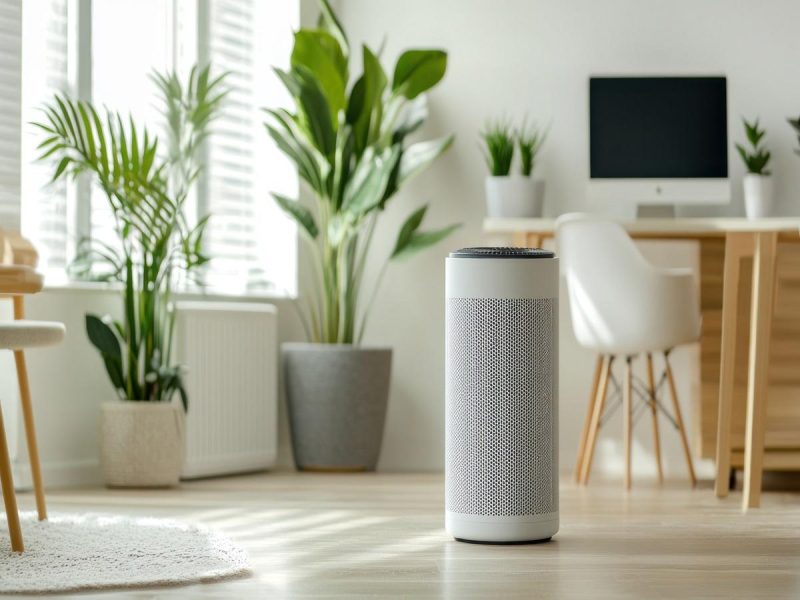No longer just utilitarian purchases, the appliances have morphed into a style statement for the house while embracing the next level in green tech, design and enhanced functionality
Ever heard of a ceiling fan with a three-stage air purifier, filtering the PM 2.5 and PM 10 pollutants along with VOCs (volatile organic compounds)? Or one with an antimicrobial surface coating, 50 per cent more energy efficiency and quieter than the standard induction motor fans. Yes, fans have significantly upped their green as well as technology quotient, apart from growing on looks and aesthetics.
The Coronavirus pandemic has triggered the demand for high-quality fans. Says Krishna Raman, Business Head-Consumer Products, Bajaj Electricals Ltd, “During the pandemic, we saw consumers upgrading their home appliances, and the fan industry reaped some benefits from this. Today consumers are demanding more features than just air throw, and aesthetically pleasing smart fans are in great demand.”
What’s trending
The market has a complete range of fans for every application. The ceiling fans come in a range of colours and finishes, and there are a host of brands such as Usha International, Crompton, Atomberg, Luminous, Orient Electric, Bajaj Electricals, Havells, Khaitan, The White Teak and Luxaire, which retail from Rs 2,000 to upwards of Rs 20,000.
Luxaire, for instance has some 600 designs, with nine international brands across models such as solid wooden blade ceiling fans, retractable chandelier fans or Fandeliers; funky and resort-style or BLDC modern ceiling fans. Their affordable luxury fans start at Rs 20,000. Says Nisha Kukrejah, Founder, Luxaire Luxury Fans, “Consumers do not opt for the mundane and ordinary any more. They try to keep themselves apart from the rest of the crowd by opting for exclusive designs and high-end functionality. They now have access to technology that helps them discover the very best of what the world has to offer and Indian consumers don’t shy away from going after high-end luxury décor products, fans being no different.”
Havells recently launched what it claims is an industry-first ceiling fan, Stealth Puro Air, which has a three-stage air purifier that filters PM 2.5 and PM 10 pollutants along with VOC filtration, and offers an approximate Clean Air Delivery Rate (CADR) of 130 cu m/hr. It is priced at Rs 15,000. Says Ravindra Singh Negi, President-Electrical Consumer Durables, Havells India Ltd: “The spike in health issues caused by air pollution make the use of an air purifier an absolute necessity to ensure the well-being of one’s family. Havells has used comprehensive R&D focused on these health problems to develop India’s first air-purifying ceiling fan to fulfil a basic need–that of clean air.”
Polycab fans are available in a price range of Rs 1,400-13,500. They have launched an innovative range under ‘Purocoat’ range, with Nanova Technology, an antimicrobial surface coating that keeps the fan surface free from bacteria, rust and dust, and prevents the colour from fading. But the most energy-efficient ceiling fans currently available in the market are those that use brushless direct current electric motors (BLDC motors), a technology that requires an electronic motor controller to drive the rotor.
Says Tapas Chowdhury, President-Fans and Home Appliances, Polycab India Ltd: “BLDC motors use an electronic chip to convert the input AC current to DC current. When no brushes are used, the frictional loss of current results in lower noise. It can deliver the same performance even when the voltage fluctuates, unlike conventional fans whose speed dips drastically with a drop in voltage. BLDC fans consume up to 65 per cent less electricity than regular fans and are priced at Rs 2,800 to 20,000 depending on features, material, aesthetics etc.”
Then there are smart IoT-enabled fans that can be controlled with smart apps, making our lives easier. The latest ones come with smart remotes and have features like speed control, timer mode, and LED speed indicators. They can be controlled via different apps and don’t require a regulator.
Room size, design, décor, colour and air delivery are the key parameters consumers look for while buying a fan. Says Rohit Mathur, President, Electric Fans, Water Heaters & Pumps, Usha International: “Fans are available in various sweep sizes from 600 mm to 1,400 mm, depending on the size of the room. We have a wide range to choose from such as those with Goodbye dust technology, ABS moulded aerodynamically designed blades for higher air circulation and air delivery. Our premium range is equipped with either a powerful precision-crafted motor or a high-torque BLDC motor that improves speed control and reliability while significantly reducing power consumption and is kinder to the planet. Our latest innovations, the Usha Bloom Series, range between Rs 3,500 and Rs 5,800, and the Heleous Fan (MRP: Rs 9,890) are our top trending product lines among ceiling fans due to their aesthetic appeal and technological superiority.”
Designer fans
How are designer fans different from regular ones? Regular fans are a product of pure functionality with little or no emphasis on aesthetics. So, the difference between regular fans and designer fans is like the difference between tube lights and decorative lights. Says a spokesperson from The White Teak: “Designer fans cater to aesthetic as well as functional needs, unlike regular ones. There are many sub-types within this category. For example, there are wooden designer fans, ceiling fans with lights, chandelier fans, designer fans with fabric patterns, ceiling fans with lights and remote, LED ceiling fans with retractable blades, and so on. Each kind of designer fan has its own utility and aesthetic value. You should choose ceiling fans that serve your needs and also fit in well with your interior design.”
Both ceiling fans and air-conditioners keep the room cool. A ceiling fan would evaporate the moisture by circulating the air within the room, while an air-conditioner does the job by pumping the warm air outside and releasing cool air into the room in order to lower the temperature at the expense of increasing your monthly bill. Says Agastya Vats, a Delhi-based architect, “There is an urgent need to address the existential threat climate change poses to humanity. One solution that is crucial for developing countries like India is to increase the energy efficiency of common household appliances like ceiling fans. I’d go as far to say that a good ceiling fan can even replace the AC. Air-conditioners are people’s go-to option in the universe of cooling appliances while ceiling fans are often overlooked. ACs might provide extra cooling but with the rise in energy-saving appliances, ceiling fans have become the most suitable option for moderate to light cooling.”
How to choose
Most customers do not understand the technical aspects of fans and largely go for the aesthetics, recommendation of retailer or the brand the buyer is aware of.
The first thing to consider while buying your ceiling fan is the size of a room, as that dictates how big the ceiling fan should be. A fan that’s too small or big for the space will not circulate the air properly. Consider fans that are low in maintenance, like anti-dust, anti-rust and anti-fade, which are easy to clean. Customers should understand the basic working of a ceiling fan–essentially it functions by rotating pitched blades. These blades create air flows that produce better air circulation, thus helping “cool” the body. Apart from all other factors, one should get the fan serviced once a year, check the ball bearings, and oil it on regularly to increase its lifespan.
Bajaj Electricals’ Krishna Raman says he has seen many consumers choosing a fan based on the colour and decorative elements as they are looking to match the fans with their home décor. But some consumers also look for high speed especially in a tropical climate like ours and they also prefer a consistent air delivery/flow. The size of the room is important for the sweep selection. For example, a typical room measuring 12 sq ft x 12 sq ft could use a 48” ceiling fan while larger rooms would require a 56” ceiling fan. If the room is even smaller, then a 36” ceiling fan would work.
Says Raman: “Another emerging trend is that customers are increasingly conscious about the power-saving capability of the fan. Fans fitted with BLDC instead of conventional motors have lower energy losses, and consume less power while ensuring the service values are maintained. Service value in simple terms means the amount of air delivered per minute per watt of electricity consumed.”
Finally, having proper air circulation in your room is crucial for good sleep. A good fan will easily maintain airflow in the room and reduce stagnant odours. The room size, clear height, number of fan points in the room, design theme–all these parameters are important in the selection process. After all, ceiling fans are widely used both at night and during the day. When you are using them for a large part of the day, you must only go for the best.
Table: Specifications and prices of some premium fans available in the market
| Model and specifications | Price (Rs) |
| Havells Momenta 1,320 mm sweep, architectural bronze finish, Remote control operations, contemporary LED underlight | 62,410 |
| Marissa (52″ Span, Walnut Finish Metal Body, Walnut Finish ABS Blades) Ceiling Fan | 21,950 |
| Tahiti Treasure (36″ Span, Antique Bronze Metal Body, Teak Finish MDF Blades) Ceiling Fan | 24,800 |
| Scenic Road (44″ Span, Rose-Gold Finish Metal Body, Translucent ABS Blades) LED Chandelier Ceiling Fan | 31,950 |
| Crompton Silent Pro noiseless brown fan (Wood finish) | 15,470 |
| Havells – Stealth Puro Air (Air Purifying ceiling fan) | 15,000 |
| Orient Electric Aeroslim 1200 mm Marble White-Remote & IoT | 14,360 |
| Orient Electric Subaris 1300 mm 5 Blade Ceiling Fan Antique Brass | 7,400 |
| Crompton Silent pro Enso 1225 mm 3 Blade Ceiling Fan | 7,300 |
Credits: Market Research




